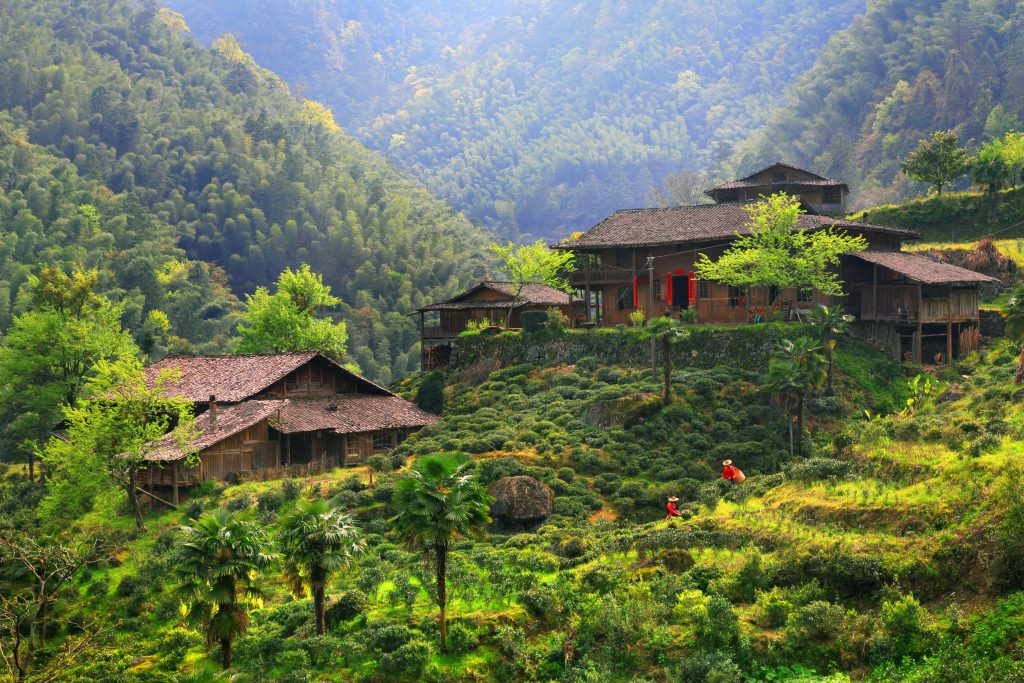$24.00 – $42.00
An older growth, heirloom bush version of classic unsmoked Lapsang 正山小种 zheng shan xiao zhong, featuring Tongmu cooling mineral "stony" flavor and mouthfeel, buttery floral aroma, enlivening body chi, and returning sweetness. A delicious red tea (aka black tea in the West) hailing from the birthplace of the genre.
The tea plant Camellia sinensis evolved in modern-day southwestern China and the Golden Triangle area, and natural differentiation between larger leaf (broadly referred to as Camellia sinensis var. assamica) and smaller leaf subspecies (broadly Camellia sinensis var. sinensis) occurred at least a handful of hundreds of thousands of years ago, and were later further dispersed and artificially selected via the cultivation of migrating human populations over the last few thousands of years.
While some sources claim the founding of Tongmu was established as early as the late Tang Dynasty in the early 900s, we know that the region, due to limitations in what it can grow, has focused on producing tea from its naturally exceptional base material since at least the late Ming Dynasty (early 1600s). Regardless of the cultivation status of the smaller leaf subspecies that had arrived in Tongmu by that time, today most of the descendant plants there are not genetically homogenous asexually propagated cuttings from a motherbush like many cultivated tea gardens. They are naturally propagated via insect pollination and subsequent seed dispersal. Over time, this produces a genetically diverse garden especially well-adapted to the environment it continues its slow evolution in.
Such is the case with Tongmu's cai cha bushes, from which all Lapsang 正山小种 zheng shan xiao zhong is derived from in Tongmu. These are the existent plants that have been growing feral wherever they are left to, up the mountain slopes, into the bamboo and pine forest undergrowth. Ask when they were planted and they'll tell you they were left by the ancestors.

The scene from the Li family house in Gu Wang Keng village, one of the smaller, more remote villages of Tongmu. The altitude here is 1000 meters. The Li family are one of just 12 households in Gu Wang Keng and have been producing tea there now for fourteen generations.
While it is reported that the estimated average age of a Tongmu tea bush across the preserve is an impressive 50 years old, the Li family has attempted to determine the age of older specimens through a combination of family knowledge and trunk size assessment. This tea is crafted from larger specimens that are estimated to be between 70-100 years old.
The Progeny of Red Tea's Renaissance
When the government-commissioned Jin Jun Mei debuted in 2006, it asked — and received — unheard of prices for the genre. Modern luxury hong cha was born and the race to emphasize higher quality inputs in existing varietals and prototype newer trendy ones to get in on the hype was underway. Genuine Jin Jun Mei hails from the birthplace of red tea — Tongmu Pass in the greater Wuyi Mountains — and the legendary area began to rightfully receive more attention with the help of its new posterchild.
If this incentive to pivot from producing the old smoky export black teas to higher earning fashionable domestic products wasn't enough, the government banned the harvest of wild pine in the protected preserve in 2020 (as well as the import of outside pine), effectively decommissioning the old 青楼 Qing Lou smokehouses of Tongmu. Focusing on producing high quality unsmoked iterations became paramount to Tongmu farmers.
With demand for unsmoked Lapsang 正山小种 zheng shan xiao zhong increasing, room to expand upon varietals within that umbrella was afforded. The Li family Orchid Grotto and Tongmu Old Bush are just this: twists on the classic unsmoked lapsang style, with an emphasis on differentiated raw material inputs prior to production.
Little ol Tongmu: the birthplace of the most global style of tea
桐木关 Tongmu Guan or Tongmu Pass is a hinterland region of the larger Wuyi Mountain area in northern Fujian and is considered to be the birthplace of 红茶 hong cha (literally "red tea"), known as black tea in the West. It happened by accident when a troop of soldiers making their way through the mountains along the provincial border of Jiangxi and Fujian took an less-common route and happened upon Tongmu in the midst of spring tea season. Its villagers taken by surprise, they abandoned their fresh-harvest of laid out withering leaves and ran for the hills. Upon their return, they found their leaves oxidized and damaged due to the soldiers having slept on them! In a last ditch effort to salvage the tea someone thought to burn some of their locally abundant pine tree species, letting the smoke dry out the spoiled looking leaves. The prepared tea of this intervention turned out to be well-received, and not only was red tea AKA black tea invented, the smoky version 正山小种 zheng shan xiao zhong or later known as Lapsang Souchong was also invented. The rest is history.
The dry warmed aroma in a gaiwan hints at the session’s fragrance. Floral, wood, leather and fresh cut grass come to mind. Minerality and spice at the first sip. Sweetness and lingering flavors in the throat. Hydrating mouth sensation. Tobacco with honey sweetness and nice chi feeling. Slight campfire and abundant returning fragrance.